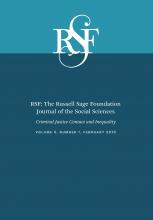Research Article
Open Access
Where the Other 1 Percent Live: An Examination of Changes in the Spatial Concentration of the Formerly Incarcerated
David S. Kirk
RSF: The Russell Sage Foundation Journal of the Social Sciences February 2019, 5 (1) 255-274; DOI: https://doi.org/10.7758/RSF.2019.5.1.11
David S. Kirk
aProfessor of sociology at the University of Oxford and professorial fellow of Nuffield College.

REFERENCES
- ↵
- Allard, Scott W.
- ↵
- American Communities Project
- ↵
- ↵
- Blumstein, Alfred, and
- Jacqueline Cohen
- ↵
- Carson, E. Ann, and
- Joseph Mulako-Wangota
- ↵
- Chaskin, Robert J., and
- Mark L. Joseph
- ↵
- Chicago Housing Authority
- ↵
- Clear, Todd R.
- ↵
- Federal Interagency Reentry Council
- ↵
- Fischer, Will, and
- Barbara Sard
- ↵
- Garland, David
- ↵
- Glaeser, Edward, and
- Jacob Vigdor
- ↵
- Grusky, David,
- Bruce Western, and
- Christopher Wimer
- ↵
- ↵
- Hyra, Derek S.
- Joint Center for Housing Studies of Harvard University
- ↵
- Joint Center for Housing Studies of Harvard University
- Joint Center for Housing Studies of Harvard University
- ↵
- Kirk, David S.
- ↵
- Kirk, David S.
- ↵
- ↵
- Kirk, David S.
- ↵
- ↵
- Kirk, David S., and
- John H. Laub
- ↵
- Kirk, David S., and
- Sara Wakefield
- ↵
- Kneebone, Elizabeth
- ↵
- Kneebone, Elizabeth, and
- Alan Berube
- ↵
- Kneebone, Elizabeth, and
- Steven Raphael
- ↵
- Krysan, Maria, and
- Kyle Crowder
- ↵
- Langan, Patrick A., and
- David J. Levin
- ↵
- La Vigne, Nancy G.,
- Vera Kachnowski,
- Jeremy Travis,
- Rebecca Naser, and
- Christy Visher
- ↵
- La Vigne, Nancy G.,
- Cynthia A. Mamalian,
- Jeremy Travis, and
- Christy Visher
- Lee, Keunbok,
- David J. Harding, and
- Jeffrey D. Morenoff
- ↵
- Maguire, Kathleen
- ↵
- Massey, Douglas S., and
- Nancy A. Denton
- ↵
- Massoglia, Michael,
- Glenn Firebaugh, and
- Cody Warner
- ↵
- National Research Council (NRC)
- ↵
- Pattillo, Mary
- ↵
- Piketty, Thomas
- Reardon, Sean F., and
- Kendra Bischoff
- ↵
- Sampson, Robert J.
- Sampson, Robert J.
- ↵
- ↵
- Schwartz, Alex F.
- ↵
- Shannon, Sarah K. S.,
- Christopher Uggen,
- Jason Schnittker,
- Melissa Thompson,
- Sara Wakefield, and
- Michael Massoglia
- ↵
- Sharkey, Patrick
- ↵
- Simes, Jessica T.
- ↵
- ↵
- Tach, Laura, and
- Allison Dwyer Emory
- ↵
- U.S. Government Accountability Office (GAO)
- ↵
- Wakefield, Sara, and
- Chris Uggen
- ↵
- Western, Bruce
- ↵
- Western, Bruce
- ↵
- Wilson, William J.
In this issue
Where the Other 1 Percent Live: An Examination of Changes in the Spatial Concentration of the Formerly Incarcerated
David S. Kirk
RSF: The Russell Sage Foundation Journal of the Social Sciences Feb 2019, 5 (1) 255-274; DOI: 10.7758/RSF.2019.5.1.11
Jump to section
Related Articles
- No related articles found.
Cited By...
- No citing articles found.





